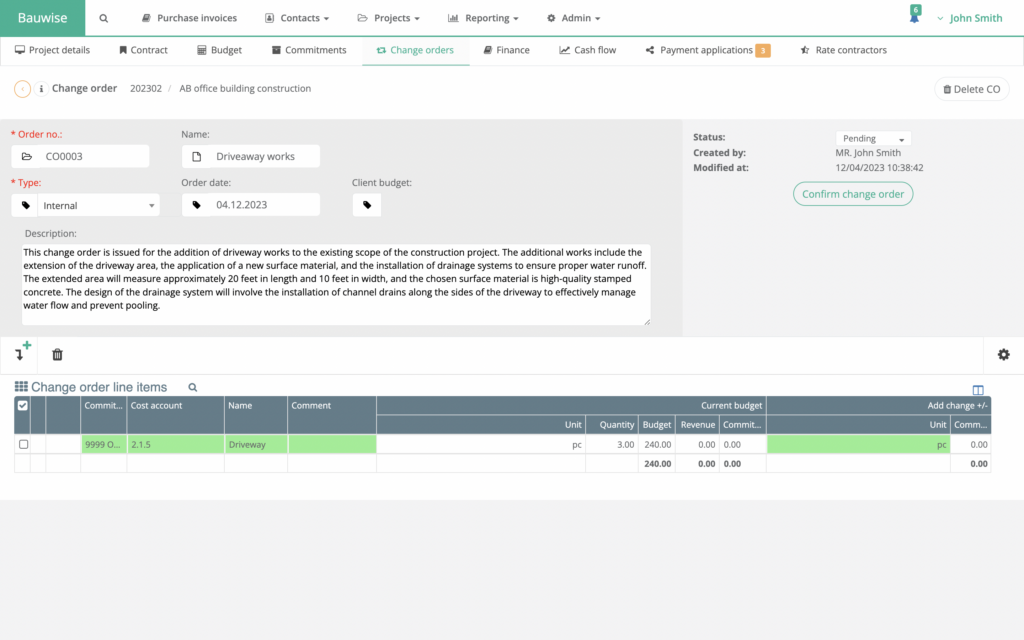Table of Contents
A well-structured change order should comprehensively cover several key elements to ensure clear communication and agreement on the changes being made to a construction project. Efficiently filling out a change order can significantly mitigate risks, increase the probability of its approval, and expedite the payment process for contractors. Here are the essential components that should be included in the construction change order:
1. Project and Contact Information
The change order form should list the following:
- Contract number
- Owner’s name and contact details
- General contractor or architect’s name and contact details
- Project name and address
- Contractor’s name and contact details
- Change order number (indicating the sequence of submitted orders)
This information is crucial for linking the change order to a specific contract, especially in large commercial projects or government contracts.
2. Change Order Dates
Include the date of completion for the change order. Other dates, like the initial notification of the change or the submission date for approval, may also be important depending on the contract. Timely notification of changes is often required, with typical notification periods ranging from 5–10 days, varying by contract. Failure to comply with these procedures can lead to rejection or payment delays. It’s crucial for contractors to thoroughly review their construction contracts to understand the precise requirements and procedures for submitting a change order.
3. Detailed Change Description
This section is where contractors must detail what will change in the work. These could be additional tasks they take on or parts of the project that are no longer needed. Contractors need to be clear and detailed here, considering that someone reading this may not know the project as well as they do.
It is also essential to clearly state the reasons for the change, as they help explain why it should be approved. These changes can be due to many different things – perhaps site conditions are different than expected, the design or scope of the project has changed, there have been new laws or regulations, or there have been unexpected events such as a strike, vandalism, severe weather, or even something significant, such as force majeure event. It’s a fancy term for things entirely out of anyone’s control but still affect the project.
Contractors should be very specific when explaining these changes. For example, adding written descriptions, photos, or drawings helps paint a clear picture of why a change is needed.
It is good to remember that the change order may be viewed by lawyers or people unfamiliar with the construction world. So, packing as many details as possible is a smart move to keep everyone on the same page.
4. Impact on Project Schedule
An essential aspect of the change order form is the inclusion of an updated project schedule reflecting the impact of the change. Contractors are expected to specify the additional days required to implement the change and the revised completion date.
Occasionally, project owners may request a comprehensive analysis from the contractor detailing how the change affects the project’s overall path. This analysis is particularly relevant when determining if the contractor is entitled to additional time or a schedule extension. When the change does not significantly alter the project’s critical path, contractors may not receive additional days or a time extension.
It’s important for contractors to clearly illustrate the impact of these changes, ideally through a comparative presentation of the original and revised schedules. This side-by-side comparison helps highlight specific changes and their implications on the project timeline.
5. Cost Impact
The change order form must detail the financial impact of the proposed change. This should include all relevant financial aspects, such as increased or decreased costs, overheads, profit margins, taxes, insurance, and any additional costs associated with the change. The format of the financial breakdown of this change order should match the format of the original contract.
In cases where the change involves a unit price, it is essential to provide a comprehensive breakdown of all costs involved. This breakdown should include the specifics of labor and materials, ensuring that each cost aspect is accounted for transparently and accurately.
6. Revised Contract Value
Reflect the updated contract value in all change orders. The form should show the following:
- Original contract value
- Value of all previously approved change orders
- Cost of the current change order
- New total contract value, inclusive of all change orders
These elements ensure the change order is comprehensive and transparent, aiding in its approval and integration into the ongoing construction project.
7. Approval Signatures
Include signatures from all the relevant parties, like the project owner, contractor, subcontractor, and architect or engineer, to indicate agreement and approval of the change.
- List of Signatories: Include the project owner, general contractor, project architect or engineer, and the subcontractor if needed. Ensure each person signing is an authorized representative.
- Signature and Date: Each party should sign and date the change order, confirming their consent to the modifications detailed in the document.
- Acknowledgment of Consent: The signatures indicate that all parties have read, understood, and agreed to the changes, including any adjustments to the scope of work, timeline, and cost.
- Optional Witnessing or Notarization: If required, signatures may be witnessed or notarized for added legal validity.
- Contact Information: Provide contact details like phone numbers or email addresses for further communication.
This section ensures the change order is formally agreed upon and legally binding, with clear records of who approved the modifications and when.
8. Attachments or Supporting Documents
Including attachments and supporting documents to the construction change order is crucial for providing a clear and detailed understanding of the proposed changes. These materials are the backbone for explaining the modifications, ensuring that all parties comprehensively understand the changes and their implications. The following types of documents are typically included to enhance the clarity and effectiveness of a change order:
- Detailed Drawings: Revised blueprints or sketches visually represent the changes. They can include architectural drawings, structural plans, electrical layouts, plumbing schematics, or landscape designs, depending on the nature of the change.
- Revised Specifications: Updated specifications detail the materials, workmanship, quality standards, and performance criteria for the new work. They provide a technical description of the products, materials, or services required for the change.
- Photographic evidence: You can include before and after photos or pictures that emphasize the changes. These visuals help illustrate the current state of the site and the expected result after the change.
- Engineering Reports: If the change involves structural modifications or technical complexities, engineering reports or assessments might be attached to justify the need for change and to ensure compliance with safety standards and building codes.
- Cost Estimates: A detailed breakdown of the estimated costs associated with the change. This should include labor, materials, equipment, and additional costs.
A change order’s format and specific content can vary depending on the project, the construction company, and the contractual requirements. Still, these are the typical elements you’d expect to find in such a document.
Conclusion
Including these elements in a construction change order ensures a comprehensive and transparent approach to managing changes in a construction project. It allows all stakeholders to understand changes and their impact on project scope, schedule, and budget and maintains a documented trail of accountability and project management effectiveness. To fill in a construction change order more efficiently, it is reasonable to use construction change order software where all the essential things the change order should include are automatically required to meet the necessary requirements.
Written by

Taavi Kaiv
Taavi Kaiv is a construction specialist with over ten years of experience in the construction industry. Taavi is an accomplished construction project manager with many successful projects that have been completed under his guidance. Taavi holds a master’s degree in construction management from the Tallinn University of Technology. View profile
Related content
Read our other articles where you can find helpful and relevant information about construction change orders:






